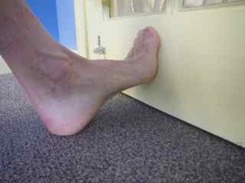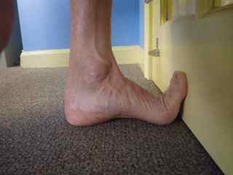|
The vast majority of foot pains are due to weak and inhibited foot muscles, both intrinsic to the foot and those originating on the lower leg. The following exercises are designed to address the more common weaknesses. The bare minimum to do are the short foot exercise while in a single leg posture and stretching the calf muscles! Check out my other foot exercises for the intrinsic muscles and do some toe ups!
The Short Foot Exercise...
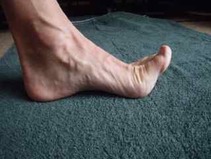 Toes extended to raise medial arch.
Toes extended to raise medial arch.
A. Short Foot Formation / Posture. This exercise is key!!!
To get an awareness of good foot posture (foot core) and to activate the small intrinsic foot muscles that support your arch, do the following: weight bear on the foot using a three-point, tripod position: the three weight bearing points are the ball of the big toe, the little toe, and the heel. Raise all of your toes as much as you can, maintaining the tripod position as shown in the photo.
Notice how the arch is raised when you extend your toes, especially the big toe. You are engaging a natural mechanism that raises the arch (Windlass mechanism of Hicks.)
Hold this position for a few seconds and slowly lower the toes only while maintaining the arch! Feel slight tension in the bottom of your foot and arch.
To get an awareness of good foot posture (foot core) and to activate the small intrinsic foot muscles that support your arch, do the following: weight bear on the foot using a three-point, tripod position: the three weight bearing points are the ball of the big toe, the little toe, and the heel. Raise all of your toes as much as you can, maintaining the tripod position as shown in the photo.
Notice how the arch is raised when you extend your toes, especially the big toe. You are engaging a natural mechanism that raises the arch (Windlass mechanism of Hicks.)
Hold this position for a few seconds and slowly lower the toes only while maintaining the arch! Feel slight tension in the bottom of your foot and arch.
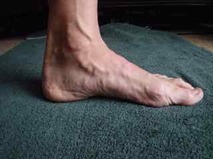 Short foot position. Notice the medial arch is maintained after the toes are relaxed down.
Short foot position. Notice the medial arch is maintained after the toes are relaxed down.
Just lower the toes, not the arch. Hold this raised arch position for one minute. This is the SHORT FOOT position. When you raise the arch, the foot length actually shortens slightly, thus, it’s name. It is a posture of stability and needed for proper foot function.
Make sure your knee is pointing over the center of your foot. Hold the position for 30 seconds. Repeat the short foot exercise several times in the following positions:
Sitting
Standing. Try leaning slightly forward.
Half lunge with leaning forward.
Repeat this as often as you can through the day!
Make sure your knee is pointing over the center of your foot. Hold the position for 30 seconds. Repeat the short foot exercise several times in the following positions:
Sitting
Standing. Try leaning slightly forward.
Half lunge with leaning forward.
Repeat this as often as you can through the day!
|
B. Short foot exercise in single leg balance. EXCELLENT EXERCISE!!
This exercise has been shown to maximally activate the intrinsic foot muscles that support the arch. Perform single leg balancing while holding the short foot formation. With eyes open and fixed on a point across the room, try to balance with good form for 30-60 seconds on each leg. Repeat until tired. Then try it with eyes closed for 10 seconds. |
Stretches...
A. Calf Stretching
Stretching the Achille’s tendon is critical to good foot function, especially for feet that suffer from plantar fasciitis. Using the weight of your body, hang your heels off of a step while holding onto the railing for balance. Stretch for 30-60 sec. Repeat several times a day at first. (Every 2 hours). Keep your knees straight for 30 seconds, then bend your knees very slightly to feel a different stretch for 30 seconds. For more of an aggressive stretch, do this on one leg at a time.
Stretching the Achille’s tendon is critical to good foot function, especially for feet that suffer from plantar fasciitis. Using the weight of your body, hang your heels off of a step while holding onto the railing for balance. Stretch for 30-60 sec. Repeat several times a day at first. (Every 2 hours). Keep your knees straight for 30 seconds, then bend your knees very slightly to feel a different stretch for 30 seconds. For more of an aggressive stretch, do this on one leg at a time.
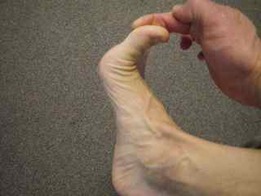
B. Big Toe Stretch
This stretches the plantar fascia and the muscles/ tendons attaching to the big toe. Pull the big toe back and hold for 30-60 sec. Repeat as often as you can through the day. You can also press your toe against a wall.
This stretches the plantar fascia and the muscles/ tendons attaching to the big toe. Pull the big toe back and hold for 30-60 sec. Repeat as often as you can through the day. You can also press your toe against a wall.
|
Another way to stretch the big toe and the plantar fascia is with the wall slide method. It is a little more aggressive and should not be done if you have restricted big toe extension range of motion (Hallux limitus or rigiditus)
Place the ball of your foot against a wall or door as shown. Gently press your foot to the floor as your big toe is bent back. You should be standing using a three point stance: the ball of your big toe, ball of your little toe, and heel should all be on the floor. Hold for 30 seconds. Repeat three times. |
